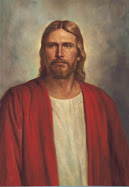I think the first time I truly came to pay attention to this song was when Mom, my Seminary teacher for the Doctrine & Covenants/Church History year, asked me to play this for our opening hymn. 6/8? 3 flats? Unfamiliar rhythm? Yes, it stood out in memory quite well. Aside from its name doing so, and the rhyming being just slightly off because of word pronunciation. A couple of years later we college students sang this on the bus as we pulled out of Nauvoo on another Travel Study trip--this time one of our stops being Adam-ondi-Ahman itself. And then almost a decade later, my baby brother and his friends sang this as an a cappella quartet at their Seminary graduation. Over that 12 year span, I noticed this song more often. I have the tune memorized as well as various phrases from the first verse. Written by our Brother Phelps, it refers to the place where Adam dwelled, and talks of Enoch's Zion (as Brother Phelps did in Hymn #48), and looks forward to the glorious second coming when life on earth can be as it was in Adam-ondi-Ahman.
From the history book
The previous hymn's history had mentioned that the word Adam-ondi-Ahman was carried over from the pure Adamic language into English, one that we haven't been given a revealed, literal translation for--all this as defined by Bruce R. McConkie. Elder McConkie actually used all 4 verses of this hymn in his definition of it in Mormon Doctrine. He also went on to talk about the great spiritual gathering that occurred there 5,000 years ago where remnants of the altar that Adam offered sacrifice remained through the years; I have seen those remnants myself.
And he mentioned how in 1838 Joseph Smith and other brethren visited that place, called Spring Hill, and that the Prophet prophesied of the council that would take place again in preparation for Christ to reign personally on the earth (verse 4 of the hymn referencing that even though this hymn was written before the Prophet taught that on Spring Hill). The hymn inplies that the City of Enoch was in this spot as well. I don't know if there is any scriptural or revelatory evidence on that, but even if it wasn't in the same spot, the same thing of the people walking with God happened in the City of Enoch as it did when Adam dwelt there and walked with God.
This hymn was sung at the Kirtland Temple dedication in 1836, meaning 3 of Brother Phelps' hymns were sung there. And the book mentions the 3 slight changes to text compared to the original printing in the 1835 hymnal. One of them makes me laugh, because it took away one of Brother Phelps' attempts to make the rhyming work better. One was changing old to all. And the other was calling the hymn by its current title, rather than its first line as it had been in previous hymnals.




No comments:
Post a Comment